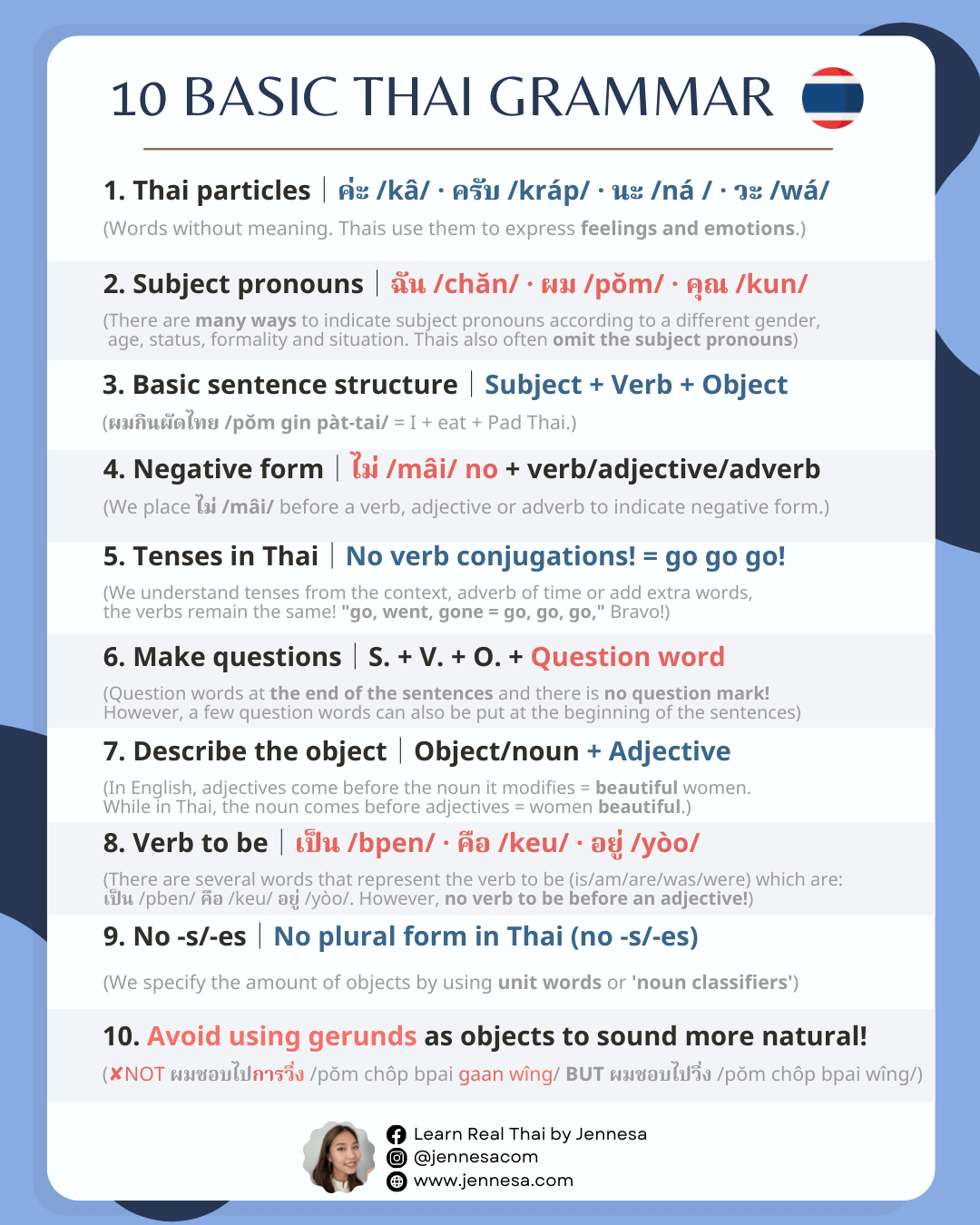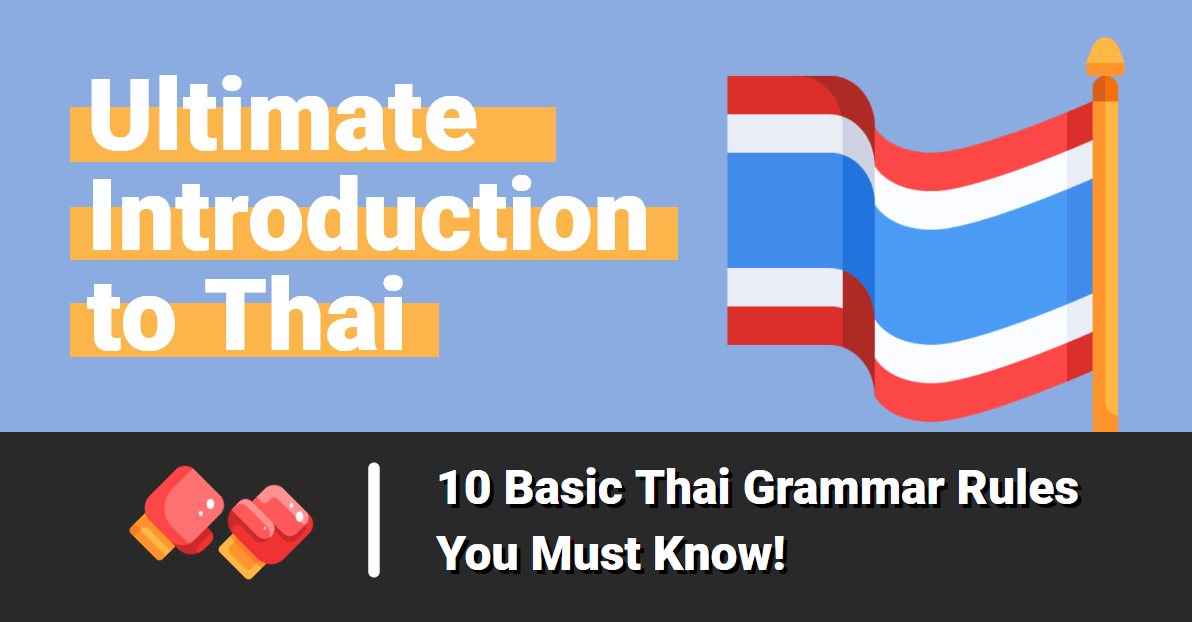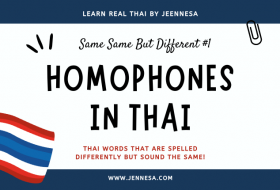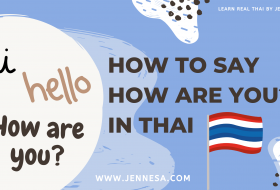Welcome to the ultimate introduction to Thai language basics — all the basics you must know!
In this blog, you’ll learn Thai language basics, basic grammar rules, basic sentence structures and everything you need to know to learn Thai language. I’m Jennesa, a native Thai teacher and I’m here to help you through your learning journey. Let’s get started!
Introduction to Thai
Thai language
Thai language (ภาษาไทย /paa-săa tai/) is the national language of Thailand. It has its own script and it is a tonal language. ภาษาไทย /paa-săa tai/ or ภาษากลาง /paa-săa glaang/: Central Thai or Standard Thai is the official language of Thailand and is used in the central of Thailand and throughout Thailand. Central Thai is the dialect taught in schools as it is understood by most Thai people from around the country.
However, there are also local Thai dialects in different parts of Thailand as well.
- ภาษาเหนือ /paa-săa nŭea/: Northern dialect is spoken in the northern region.
- ภาษาอีสาน /paa-săa e-săan/: North-eastern dialect is spoken in the north-eastern region.
- ภาษาใต้ /paa-săa dtâi/: Southern dialect is spoken in the southern region.
These local Thai dialects are written and spoken slightly different from Central Thai but many words could be also completely different.
Thai 5 tones
Thai language has 5 tones in total which are: mid, low, falling, high and rising. Why tones are tones important? Because the tones determine the meaning of words and the tones can change the meaning of one word to another word.
Thai alphabet
Thai alphabet or Thai script (อักษรไทย /àk-sŏn tai/) has 44 consonants (พยัญชนะ /pá-yan-chá-ná/) and 32 vowels (สระ /sà-rà/). The vowel can be grouped as short vowels (สระเสียงสั้น /sà-rà-sĭang-sân/) and long vowels (สระเสียงยาว /sà-rà-sĭang-yaao/). In addition, Thai language also has special characters and 4 tone marks.
Thai transcription
You may find many ways to write Thai transcription or Thai Romanization (AKA to write Thai in English) as each Thai person, each teacher, each language school or even each language app uses their own system to teach Thai to foreigners.
For example:
- Hi/hello in Thai is สวัสดี can be written as Sà-wàt-dee, Sa-wad-dii, Sa-wut-dee, etc.
Which one is correct!? Unfortunately, there is no standardized method for transcribing Thai! The International Phonetic Alphabet (IPA) system isn’t widely used. The Royal Thai General System of Transcription (RTGS) is commonly used but it doesn’t indicate the right vowel length or tones. Moreover, it also isn’t consistent…
Thai transcription is just a rough guideline to make it easier for those who can’t read Thai alphabet. Learning Thai alphabet can open many new doors to immerse yourself in Thailand but even so it’s possible to learn speaking and listening without knowing Thai alphabet too! So if your goal is to speak Thai, you should focus on building confidence to speak Thai and try to copy and mimic the tones and pronunciation from native Thai speakers. In other words, don’t focus on remembering Thai transcription!
10 Basic Thai Grammar Rules You Must Know
1. Thai particles
What is a Thai particle? It is a word without meaning. We use it in our daily conversation to express our feeling and emotion. In English, asking someone “Sorry, what?” or “WHAT!?”, depending on the tone of the voice can completely change the feeling and mood of a sentence. While in Thai, we use particles.
The most common and well known are polite particles : ค่ะ /kâ/ คะ /ká/ (for female speakers) and ครับ /kráp/ (for male speakers). They are added at the end of sentences in order to make the sentence polite.
For example:
- สบายดีไหม
- /sà-baai dee măi/
- How are you? (neutral – both female and male speakers)
- สบายดีไหมคะ
- /sà-baai dee măi ká/
- How are you? (polite – female speakers)
- สบายดีไหมครับ
- /sà-baai dee măi kráp/
- How are you? (polite – male speakers)
But, not using them doesn’t mean you are being rude, you can drop them if you are talking to friends or someone you are close to. However, if you bump into someone on the street it would be slightly rude to just say ขอโทษ /kŏr tôht/ as ‘sorry’ on its own while saying ขอโทษค่ะ /kŏr tôht kâ/ or ขอโทษครับ /kŏr tôht kráp/ would be more polite.
2. Subject pronouns
There are many ways to indicate subject pronouns in Thai according to a different gender, age, status, formality and situation.
According to gender, ‘I’ in Thai could be ฉัน /chăn/ (for female speakers) and ผม /pŏm/ (for male speakers).
For example:
- ฉันสบายดีค่ะ
- /chăn sà-baai dee kâ/
- I’m fine. (female speakers)
- ผมสบายดีครับ
- /pŏm sà-baai dee kráp/
- I’m fine. (male speakers)
Note: In Thai, the native speakers rarely say I or you when speaking to others. We don’t use first/second-person pronouns when the subject is understood. (When people know you’re making a statement, or when the person you’re talking to knows you’re talking to them).
For example:
- สบายดีค่ะ
- /sà-baai dee kâ/
- (I’m) fine. (female speakers)
- สบายดีครับ
- /sà-baai dee kráp/
- (I’m) fine. (male speakers)
3. Basic sentence structure
Thai sentence structure or word order starts from left to right. The basic sentence structure is very simple: Subject + Verb + Object. Written Thai uses no space between words.
For example:
- ผมกินผัดไทย
- /pŏm gin pàt-tai/
- I eat Pad Thai.
- ผมชอบอาหารไทย
- /pŏm chôp aa-hăan tai/
- I like Thai food.
4. Negative form
The word ไม่ /mâi/ indicates negative form in Thai, which is similar to ‘not or no’ in English. We place ไม่ /mâi/ before a verb, adjective or adverb to indicate negative form.
For example:
- ผมไม่ชอบอาหารไทย
- /pŏm mâi chôp aa-hăan tai/
- I don’t like Thai food.
- ไม่อร่อย
- /mâi à-ròi/
- Not delicious.
- ไม่เผ็ด
- /mâi pèt/
- Not spicy.
5. Tenses in Thai
Luckily, there are no verb conjugations in Thai! We don’t need to change the verb form at all. We understand tenses from the context, adverb of time and we just add extra words to indicate different tenses in Thai, the verbs remain the same! Bravo!
For example:
- Present Simple: Subject + Verb + Object
- ผมกินข้าว
- /pŏm gin kâao/
- I eat (rice/meal).
- Present Continuous: Subject + กำลัง (-ing) + Verb + Object + อยู่ (-ing)
- ผมกำลังกินข้าวอยู่
- /pŏm gam-lang gin kâao yòo/
- I am eating (rice/meal).
- Past Simple: Subject + Verb + Object + แล้ว already (or yesterday/etc.)
- ผมกินข้าวแล้ว
- /pŏm gin kâao láew/
- I ate (rice/meal) already.
- Future Simple: Subject + จะ will + Verb + Object (+ tomorrow/etc.)
- ผมจะกินข้าว
- /pŏm jà gin kâao/
- I will eat (rice/meal).
Note: Adverbs of time such as today, yesterday, tomorrow can be put in the beginning or at the end of the sentences.
6. Make questions
In English, you have to reform affirmative sentences to question sentences. While in Thai, the question sentence structure is simple: Subject + Verb + Object + Question word. We put question words at the end of the sentences and there is no question mark!
For example:
- English: Question word + sentence?
- What do you like to eat?
- Thai: Subject + Verb + Object + Question word.
- คุณชอบกินอะไร
- /kun chôp gin à-rai/
- (You-like-eat-what?)
Note: A few question words can also be put at the beginning of the sentences, such as who (ใคร /krai/), when (เมื่อไหร่ /mêuua-rài/) and why (ทำไม /tam-mai/).
7. Describe the object in Thai
In English, adjectives come before the noun it modifies. While in Thai, the object/noun comes before adjectives.
For example:
- English: Adjective + Object/noun
- black car
- beautiful women
- Thai: Object/noun + Adjective
- รถสีดำ
- /rót sĕe-dam/
- car black
-
- ผู้หญิงสวย
- /pôo-yĭng sŭay/
- women beautiful
8. Verb to be
In Thai, we have several words that represent the verb to be (is/am/are/was/were) which are: เป็น /bpen/ คือ /keu/ อยู่ /yòo/.
For example:
- เธอเป็นคนสวย
- /ter bpen kon sŭay/
- She is a beautiful person.
- นี่คือแมวของผม
- /nêe keu maew kŏng pŏm/
- This is my cat.
- ผมอยู่บ้าน
- /pŏm yòo bâan/
- I am home.
However, we don’t use the verb to be before an adjective.
For example:
- English: He is cute.
- Thai: He cute (no verb to be before an adj.!)
- เขาน่ารัก
- /kăo nâa-rák/
9. No plural form
There is no plural form in Thai (no -s/-es) but we specify the amount of objects by using unit words! The Thai word for ‘unit words’ translates closer to a ‘noun classifier’, is ลักษณนาม /lák-sà-nà-naam/. We have unique unit words for each noun/object.
For example:
- English: I have 3 dogs.
- Thai: I have -> dog [object] -> 3 [number] -> [unit word for the object]
- ผมมีหมา 3 ตัว
- /pŏm mee măa săam dtua/
- I have dog 3 units
ตัว /dtua/ is the unit word for animals, clothing, and furniture.
-
- ผมมีรถ 2 คัน
- /pŏm mee rót sŏng kan/
- I have car 2 units
คัน /kan/ is the unit word for cars/vehicle.
-
- ฉันเอาอันนี้ 5 อัน
- /chăn ao an née hâa an/
- I’ll take this one 5 units
อัน /an/ is the unit word for general objects.
Note: there are more unit words in Thai. If you have no idea about what unit word to use for something, you’ll at least be understood if you use อัน /an/.
10. Avoid using gerunds as objects
Unlike English, in Thai we can use verb + verb + verb. So please avoid using gerunds to sound more natural! Your best friend, Google Translate, might tell you the word ‘drinking’ in Thai is การดื่ม /gaan dèum/ but we don’t commonly use gerunds as objects in Thai.
For example:
- English: Stop drinking
- Thai: Stop drink
- ✓ หยุดดื่ม
- /yùt dèum/
-
- ✘ NOT หยุด
การดื่ม - /yùt
gaandèum/
- ✘ NOT หยุด
- English: I like to go running
- Thai: I like to go run
- ✓ ผมชอบไปวิ่ง
- /pŏm chôp bpai wîng/
-
- ✘ NOT ผมชอบไป
การวิ่ง - /pŏm chôp bpai
gaanwîng/
- ✘ NOT ผมชอบไป
Note: การ /gaan/ is a prefix which converts a verb or adjective into a gerund or verbal noun.

That’s it for the ultimate introduction to Thai language basics — all the basics you must know! I hope these rules help you enhance your Thai skills and help you understand Thai language better. Also check out the useful tips if you want to speak Thai like a native. >> How to speak Thai like a native!
If you would like to learn Thai online or just want to improve your communication skills in Thai: learn more about Thai grammar and learn to speak Thai, please check out my Thai lessons! All these rules will be explained in more detail using my easy and clear explanation. ?







Comments